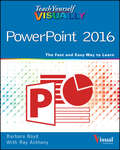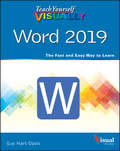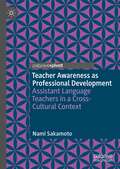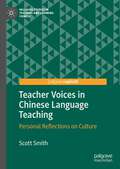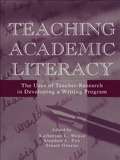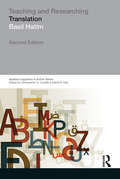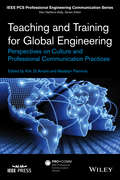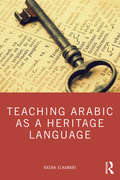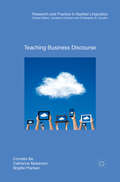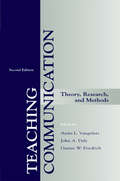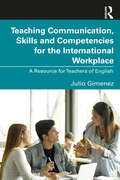- Table View
- List View
Teach Yourself VISUALLY PowerPoint 2016 (Teach Yourself VISUALLY (Tech))
by Barbara BoydThe uncomplicated PowerPoint guide designed specifically for visual learners Are you a visual learner who wants to spend more time working on your presentations than trying to figure out how to create them? Teach Yourself Visually PowerPoint offers you an effortless approach to creating winning presentations with the latest version of PowerPoint. This accessible resource features visually rich tutorials and step-by-step instructions that will help you understand all of PowerPoint's capabilities—from the most basic to the most advanced. With Teach Yourself Visually PowerPoint, you'll learn how to create slides, dress them up using templates and graphics, add sound and animation, present in a business or Internet setting, and so much more. Covering the latest additions and changes in the new version of PowerPoint, a series of easy-to-follow, full-color tutorials helps you to quickly get up and running using PowerPoint like a pro! Highly visual tutorials and step-by-step screenshots make lessons easy to follow and understand Helps you learn the basic functions of PowerPoint—and beyond Walks you through PowerPoint's latest features Demonstrates how to create memorable and captivating presentations using PowerPoint Do you prefer instructions that show you how to do something—and skip the long-winded explanations? If so, Teach Yourself Visually PowerPoint is for you.
Teach Yourself VISUALLY Word 2007 (Teach Yourself VISUALLY (Tech) #45)
by Elaine MarmelCovers the much-anticipated new features of Word 2007, including collaboration tools, XML tags in Word, and the Word 2007 facelift-the first redesigned UI since Office 97 Ideal for users migrating from older versions of Word and who want to get up to speed on the changes in the application Filled with clear, step-by-step screen shots that show readers how to tackle dozens of Word tasks, including new features like the Research Pane, side-by-side comparisons, smart tags, and maximizing the benefits of the Task Pane Revised interior design offers readers a more sophisticated look with easier navigation
Teach Yourself VISUALLY Word 2010 (Teach Yourself VISUALLY (Tech) #58)
by Elaine MarmelLearn to use Microsoft Word 2010 the easy, visual way Word is the most popular application in the Microsoft Office suite, and Word 2010 has some exciting new features. If you learn best when you can see how something is done, you'll find the step-by-step instructions and full-color screen shots make it quick and easy to learn this new version of Word. The visual format helps you understand Word's new features, including Web Apps and the revised user interface. Learn to set up and format documents, work with graphics, use Mail Merge, post documents to the Web, and more. Word 2010 includes support for typographic features that enable you to create more sophisticated documents This guide shows how to use the new features with step-by-step instructions and full-color views of what you see on the screen at each step Perfect for visual learners who like to see how something is done Covers dozens of common tasks you will use every day Teach Yourself VISUALLY Word 2010 gets you up to speed on the new version of Word quickly and easily.
Teach Yourself VISUALLY Word 2013 (Teach Yourself VISUALLY (Tech))
by Elaine MarmelGet up to speed on the newest version of Word with visual instruction Microsoft Word is the standard for word processing programs, and the newest version offers additional functionality you'll want to use. Get up to speed quickly and easily with the step-by-step instructions and full-color screen shots in this popular guide! You'll see how to perform dozens of tasks, including how to set up and format documents and text; work with diagrams, charts, and pictures; use Mail Merge; post documents online; and much more. Easy-to-follow, two-page lessons make learning a snap. Full-color, step-by-step instructions show you how to perform all the essential tasks of Microsoft Word 2013 Explains how to set up and format documents, edit them, add images and charts, post documents online for sharing and reviewing, and take advantage of all the newest features of Word Previous editions have sold more than 220,000 copies The Visual learning system makes it easy to learn more while reading less Teach Yourself VISUALLY Word 2013 helps you master the most popular word processing program quickly, easily, and visually.
Teach Yourself VISUALLY Word 2013 (Teach Yourself VISUALLY (Tech))
by Elaine MarmelGet up to speed on the newest version of Word with visual instruction Microsoft Word is the standard for word processing programs, and the newest version offers additional functionality you'll want to use. Get up to speed quickly and easily with the step-by-step instructions and full-color screen shots in this popular guide! You'll see how to perform dozens of tasks, including how to set up and format documents and text; work with diagrams, charts, and pictures; use Mail Merge; post documents online; and much more. Easy-to-follow, two-page lessons make learning a snap. Full-color, step-by-step instructions show you how to perform all the essential tasks of Microsoft Word 2013 Explains how to set up and format documents, edit them, add images and charts, post documents online for sharing and reviewing, and take advantage of all the newest features of Word Previous editions have sold more than 220,000 copies The Visual learning system makes it easy to learn more while reading less Teach Yourself VISUALLY Word 2013 helps you master the most popular word processing program quickly, easily, and visually.
Teach Yourself VISUALLY Word 2016 (Teach Yourself VISUALLY (Tech))
by Elaine MarmelVisually learn the latest version of Word Are you a visual learner who prefers to see how Word works instead of hear a long-winded explanation?Teach Yourself Visually Word offers you a straightforward 'show me, don't tell me' approach to working with the newest version of the top-selling application in the Microsoft Office suite. Packed with visually rich tutorials and step-by-step instructions that will help you come to grips with all of Word's capabilities, this accessible resource will quickly and easily get you up and running on using the world's most widely used word processing program. With Teach Yourself Visually Word, you'll learn how to perform dozens of tasks, including how to set up and format documents and text in Word; work with diagrams, charts, and pictures; use Mail Merge; post documents online; and much more. Covering the newest additions and changes to the latest version of Word, a series of easy-to-follow, full-color tutorials helps you to quickly get up and running with Word like a warrior! Tutorials and step-by-step screenshots make lessons easy to follow and understand Helps you grasp the basic functions of Word—and beyond Walks you through Word's new features Demonstrates how to set up, format, and edit Word documents If you're new to the world of Word and want a highly visual roadmap to help you put it to use for you, Teach Yourself Visually Word has you covered.
Teach Yourself VISUALLY Word 2016 (Teach Yourself VISUALLY (Tech))
by Elaine MarmelVisually learn the latest version of Word Are you a visual learner who prefers to see how Word works instead of hear a long-winded explanation?Teach Yourself Visually Word offers you a straightforward 'show me, don't tell me' approach to working with the newest version of the top-selling application in the Microsoft Office suite. Packed with visually rich tutorials and step-by-step instructions that will help you come to grips with all of Word's capabilities, this accessible resource will quickly and easily get you up and running on using the world's most widely used word processing program. With Teach Yourself Visually Word, you'll learn how to perform dozens of tasks, including how to set up and format documents and text in Word; work with diagrams, charts, and pictures; use Mail Merge; post documents online; and much more. Covering the newest additions and changes to the latest version of Word, a series of easy-to-follow, full-color tutorials helps you to quickly get up and running with Word like a warrior! Tutorials and step-by-step screenshots make lessons easy to follow and understand Helps you grasp the basic functions of Word—and beyond Walks you through Word's new features Demonstrates how to set up, format, and edit Word documents If you're new to the world of Word and want a highly visual roadmap to help you put it to use for you, Teach Yourself Visually Word has you covered.
Teach Yourself VISUALLY Word 2019 (Teach Yourself VISUALLY (Tech))
by Guy Hart-DavisMaster one of the most popular word processors ever with this essential, visual reference Teach Yourself VISUALLY: Word 2019 provides readers with a thorough and visual exploration of the 2019 edition of Microsoft Word. Written by the celebrated author of over 100 books on computing, Guy Hart-Davis, Teach Yourself VISUALLY: Word 2019 allows you to quickly get up to speed with one of the most popular word processors on the planet. The book covers all the topics you’ll need to comprehensively master Word 2019, and includes: Full-color, step-by-step instructions showing you how to perform all the essential tasks of Microsoft Word 2019 How to set up and format documents, edit them, and add images and charts How to post documents online for sharing and reviewing and take advantage of all the newest features of Word Newly updated to include the latest features of Microsoft Word, like how to collaborate on documents in real time, draw and write with the digital pen, new accessibility options and the new Resume Assistant, Teach Yourself VISUALLY: Word 2019 belongs on the shelf of anyone who wants to improve their effectiveness with this essential word processor.
Teach Yourself VISUALLY Word 2019 (Teach Yourself VISUALLY (Tech))
by Guy Hart-DavisMaster one of the most popular word processors ever with this essential, visual reference Teach Yourself VISUALLY: Word 2019 provides readers with a thorough and visual exploration of the 2019 edition of Microsoft Word. Written by the celebrated author of over 100 books on computing, Guy Hart-Davis, Teach Yourself VISUALLY: Word 2019 allows you to quickly get up to speed with one of the most popular word processors on the planet. The book covers all the topics you’ll need to comprehensively master Word 2019, and includes: Full-color, step-by-step instructions showing you how to perform all the essential tasks of Microsoft Word 2019 How to set up and format documents, edit them, and add images and charts How to post documents online for sharing and reviewing and take advantage of all the newest features of Word Newly updated to include the latest features of Microsoft Word, like how to collaborate on documents in real time, draw and write with the digital pen, new accessibility options and the new Resume Assistant, Teach Yourself VISUALLY: Word 2019 belongs on the shelf of anyone who wants to improve their effectiveness with this essential word processor.
Teacher Awareness as Professional Development: Assistant Language Teachers in a Cross-Cultural Context
by Nami SakamotoThis book examines the process of identity (re)construction for assistant language teachers (ALTs) in foreign language classrooms in Japan, using Narrative Inquiry as a tool to provide a multifaceted perspective on their personal and professional growth. To develop a thorough understanding of the classroom, the author proposes three different types of awareness from the perspective of sociocultural theory. Each type of awareness is a unique lens through which to see the teachers’ world of language teaching within the classroom. Finally, the book discusses teacher development, teaching theory, and identity based on analysis of the narrative data. The book offers useful pedagogical insights that may have implications for teacher development and principles of language team teaching for teachers, teacher trainers, ALTs, boards of education, and university students of English and language education, including English as a Foreign Language (EFL).
Teacher Voices in Chinese Language Teaching: Personal Reflections on Culture (Palgrave Studies in Teaching and Learning Chinese)
by Scott SmithThis book reports the results of an ethnographic study, focusing primarily on the experiences of four teachers of the Chinese language in Australian secondary schools. The author creates an audience for their voices as they reflect on their own understandings of culture, language teaching, and culture in language teaching through semi-structured interviews, and compares these reflections with written stimulus dialogues designed to elicit 'culture-in-language' reflections, as well as curriculum and policy documents produced by the Australian government. The book's findings indicate that teachers of the Chinese language are diverse in their views on culture, language teaching, and the ways in which culture can or should inform language teaching, and the author argues that language teacher intercultural competence cannot be assessed through a synthesis of the current English-only research literature. This book will be of interest to teachers and teacher trainers of Chinese as a foreign language, as well as students and scholars of applied linguistics and language education more broadly.
Teaching Academic Literacy: The Uses of Teacher-research in Developing A Writing Program
by Katherine L. Weese Stephen L. Fox Stuart GreeneTeaching Academic Literacy provides a unique outlook on a first-year writing program's evolution by bringing together a group of related essays that analyze, from various angles, how theoretical concepts about writing actually operate in real students' writing. Based on the beginning writing program developed at the University of Wisconsin-Madison, a course that asks students to consider what it means to be a literate member of a community, the essays in the collection explore how students become (and what impedes their progress in becoming) authorities in writing situations. Key features of this volume include: * demonstrations of how research into specific teaching problems (e.g., the problem of authority in beginning writers' work) can be conducted by examining student work through a variety of lenses such as task interpretation, collaboration, and conference, so that instructors can understand what factors influence students, and can then use what they have learned to reshape their teaching practices; * adaptability of theory and research to develop a course that engages basic writers with challenging ideas; * a model of how a large writing program can be administered, particularly in regards to the integration of research and curriculum development; and * integration of literary and composition theories.
Teaching Academic Literacy: The Uses of Teacher-research in Developing A Writing Program
by Katherine L. Weese Stephen L. Fox Stuart GreeneTeaching Academic Literacy provides a unique outlook on a first-year writing program's evolution by bringing together a group of related essays that analyze, from various angles, how theoretical concepts about writing actually operate in real students' writing. Based on the beginning writing program developed at the University of Wisconsin-Madison, a course that asks students to consider what it means to be a literate member of a community, the essays in the collection explore how students become (and what impedes their progress in becoming) authorities in writing situations. Key features of this volume include: * demonstrations of how research into specific teaching problems (e.g., the problem of authority in beginning writers' work) can be conducted by examining student work through a variety of lenses such as task interpretation, collaboration, and conference, so that instructors can understand what factors influence students, and can then use what they have learned to reshape their teaching practices; * adaptability of theory and research to develop a course that engages basic writers with challenging ideas; * a model of how a large writing program can be administered, particularly in regards to the integration of research and curriculum development; and * integration of literary and composition theories.
Teaching and Researching Translation
by Basil A. HatimTeaching & Researching Translation provides an authoritative and critical account of the main ideas and concepts, competing issues, and solved and unsolved questions involved in Translation Studies. This book provides an up-to-date, accessible account of the field, focusing on the main challenges encountered by translation practitioners and researchers. Basil Hatim also provides readers and users with the tools they need to carry out their own practice-related research in this burgeoning new field. This second edition has been fully revised and updated through-out to include: The most up-to-date research in a number of key areas A new introduction, as well as a new chapter on the translation of style which sets out a new agenda for research in this field Updated examples and new concepts Expanded references, bibliography and further reading sections, as well as new links and resources Armed with this expert guidance, students of translation, researchers and practitioners, or anyone with a general interest in this fast-developing field can explore for themselves a range of exemplary practical applications of research into key issues and questions. Basil Hatim is Professor of Translation & Linguistics at the American University of Sharjah, UAE and theorist and practitioner in English/Arabic translation. He has worked and lectured widely at universities throughout the world, and has published extensively on Applied Linguistics, Text Linguistics, Translation/Interpreting and TESOL.
Teaching and Researching Translation
by Basil A. HatimTeaching & Researching Translation provides an authoritative and critical account of the main ideas and concepts, competing issues, and solved and unsolved questions involved in Translation Studies. This book provides an up-to-date, accessible account of the field, focusing on the main challenges encountered by translation practitioners and researchers. Basil Hatim also provides readers and users with the tools they need to carry out their own practice-related research in this burgeoning new field. This second edition has been fully revised and updated through-out to include: The most up-to-date research in a number of key areas A new introduction, as well as a new chapter on the translation of style which sets out a new agenda for research in this field Updated examples and new concepts Expanded references, bibliography and further reading sections, as well as new links and resources Armed with this expert guidance, students of translation, researchers and practitioners, or anyone with a general interest in this fast-developing field can explore for themselves a range of exemplary practical applications of research into key issues and questions. Basil Hatim is Professor of Translation & Linguistics at the American University of Sharjah, UAE and theorist and practitioner in English/Arabic translation. He has worked and lectured widely at universities throughout the world, and has published extensively on Applied Linguistics, Text Linguistics, Translation/Interpreting and TESOL.
Teaching and Training for Global Engineering: Perspectives on Culture and Professional Communication Practices (IEEE PCS Professional Engineering Communication Series)
by Kirk St. Amant Madelyn FlammiaProvides a foundation for understanding a range of linguistic, cultural, and technological factors to effectively practice international communication in a variety of professional communication arenas An in-depth analysis of how cultural factors influence translation, document design, and visual communication A review of approaches for addressing the issue of international communication in a range of classes and training sessions A summary of strategies for engaging in effective e-learning in international contexts A synopsis of how to incorporate emerging media into international teaching and training practices
Teaching and Training for Global Engineering: Perspectives on Culture and Professional Communication Practices (IEEE PCS Professional Engineering Communication Series)
by Kirk St. Amant Madelyn FlammiaProvides a foundation for understanding a range of linguistic, cultural, and technological factors to effectively practice international communication in a variety of professional communication arenas An in-depth analysis of how cultural factors influence translation, document design, and visual communication A review of approaches for addressing the issue of international communication in a range of classes and training sessions A summary of strategies for engaging in effective e-learning in international contexts A synopsis of how to incorporate emerging media into international teaching and training practices
Teaching Arabic as a Heritage Language
by Rasha ElHawariTeaching Arabic as a Heritage Language is a practical guide to Arabic pedagogy for Heritage Learners of Arabic. Exploring the teaching of Arabic as a foreign language (TAFL) in North America and Europe, it covers sociocultural topics such as diglossia and religion alongside theoretical approaches to Heritage Language Learning. It also provides a new and detailed definition of the heritage language learner (HLL) of Arabic. The role of the professor and the material are explored to ensure a successful learning experience. The latest advances in HLL are considered together with the recent and recommended changes in classroom practice, giving rise to the recognition of the individual needs of heritage learners. This is an indispensable resource for instructors, researchers, and students in the fields of TAFL and TASOL, as well as linguists interested in Arabic language learning and teaching.
Teaching Arabic as a Heritage Language
by Rasha ElHawariTeaching Arabic as a Heritage Language is a practical guide to Arabic pedagogy for Heritage Learners of Arabic. Exploring the teaching of Arabic as a foreign language (TAFL) in North America and Europe, it covers sociocultural topics such as diglossia and religion alongside theoretical approaches to Heritage Language Learning. It also provides a new and detailed definition of the heritage language learner (HLL) of Arabic. The role of the professor and the material are explored to ensure a successful learning experience. The latest advances in HLL are considered together with the recent and recommended changes in classroom practice, giving rise to the recognition of the individual needs of heritage learners. This is an indispensable resource for instructors, researchers, and students in the fields of TAFL and TASOL, as well as linguists interested in Arabic language learning and teaching.
Teaching Business Discourse (Research and Practice in Applied Linguistics)
by Cornelia Ilie Catherine Nickerson Brigitte PlankenThis book presents research in business discourse and offers pedagogical approaches to teaching business discourse in both classroom and consultancy contexts that address the key issues of dealing with different types of learners, developing teaching materials and evaluation. Drawing on the authors’ extensive experience of researching business discourse from a variety of different perspectives including pragmatics, discourse analysis, rhetoric, and language for specific purposes, it demonstrates how these approaches may be applied to teaching. Each chapter includes a list of additional readings, together with a number of practical tasks designed to help readers apply the materials presented. Case studies are used throughout the book to illustrate the concepts, thus equipping readers with a set of research tools to extend their own understanding of how language and communication operate in business contexts, as well introducing them to a variety of research-based ideas that can be translated easily into a classroom setting. The book is cross-cultural in scope as it includes perspectives from a range of different contexts. It represents a significant advance in current literature and will provide a valuable resource for students and scholars of applied linguistics, business communication, and business discourse, in addition to teachers of Business English.
Teaching Children with Autism and Related Spectrum Disorders: An Art and a Science
by Christy MagnusenBased on 25 years of working with children with ASDs Magnusen contends that teachers who can blend the 'science' of education methodology with the 'art' of teaching are best able to reach these children. She takes a fresh look at established and more recent teaching methods and then explores why, when and how these techniques should be applied.
Teaching Communication: Theory, Research, and Methods
by Anita L. Vangelisti John A. Daly Gustav W. FriedrichThe field of communication was founded, in part, because of a need to make people better communicators. That meant teaching them how to communicate more effectively, whether it be in public settings or in private. Most of that teaching has happened within the classroom and many professionals have spent their lives instructing others on various aspects of communication. Inside this second edition, the editors have assembled a fully comprehensive and contemporary discussion of topics and issues concerning the teaching of communication. The chapters contained herein--contributed by key voices throughout the communication discipline--address conceptual as well as practical issues related to communication instruction. The contents of this new edition reflect the dramatic changes that have occurred in communication education since the publication of the first edition in 1990. This book focuses initially on the goals of communication education, then delves into the preparation of specific communication courses. It includes assistance for instructors in organizing instructional content and discusses the use of instructional strategies and tools, as well as offering ideas on evaluating the processes and products of instruction. The volume also covers unique teaching assignments that may be encountered, from the basic course to continuing education, and addresses 2-year college teaching, directing forensic programs, distance education, and consulting. It concludes with important professional issues faced by both new and experienced communication instructors, including ethics and political issues within classrooms and departments. This volume is a necessity for anyone starting out a career as a communication instructor. Veteran educators--who know that learning to teach is a continual growth experience--will find useful and invaluable information within the book's pages. Whatever background and level of experience, all communication educators will find this new edition to be an essential resource for their work.
Teaching Communication: Theory, Research, and Methods
by Anita L. Vangelisti John A. Daly Gustav W. FriedrichThe field of communication was founded, in part, because of a need to make people better communicators. That meant teaching them how to communicate more effectively, whether it be in public settings or in private. Most of that teaching has happened within the classroom and many professionals have spent their lives instructing others on various aspects of communication. Inside this second edition, the editors have assembled a fully comprehensive and contemporary discussion of topics and issues concerning the teaching of communication. The chapters contained herein--contributed by key voices throughout the communication discipline--address conceptual as well as practical issues related to communication instruction. The contents of this new edition reflect the dramatic changes that have occurred in communication education since the publication of the first edition in 1990. This book focuses initially on the goals of communication education, then delves into the preparation of specific communication courses. It includes assistance for instructors in organizing instructional content and discusses the use of instructional strategies and tools, as well as offering ideas on evaluating the processes and products of instruction. The volume also covers unique teaching assignments that may be encountered, from the basic course to continuing education, and addresses 2-year college teaching, directing forensic programs, distance education, and consulting. It concludes with important professional issues faced by both new and experienced communication instructors, including ethics and political issues within classrooms and departments. This volume is a necessity for anyone starting out a career as a communication instructor. Veteran educators--who know that learning to teach is a continual growth experience--will find useful and invaluable information within the book's pages. Whatever background and level of experience, all communication educators will find this new edition to be an essential resource for their work.
Teaching Communication, Skills and Competencies for the International Workplace: A Resource for Teachers of English
by Julio GimenezBacked by evidence and research, this practical book presents an innovative yet comprehensive approach to teaching non-native English speakers the main communication and cultural competencies that are required to succeed in an international English-speaking workplace. Each unit includes strategies for teaching key skills, tasks to encourage reflection and notes on relevant cultural and technological issues. Practical features in each unit include lesson plans and materials, insights from research, extension tasks, reflection activities and further readings. Supported by current learning theories, key teaching methodologies and assessment materials, the chapters address the challenges that non-native English speakers may face in the international English-speaking workplace. Areas of focus include: Job hunting Job applications Interviews Interpersonal, written and spoken communication Performance appraisals Applying for promotions Written for pre-service, practicing and future teachers, with specific guidance for each role, this is an essential resource for all educators who want to confidently address the challenges that non-English speakers may encounter at work, including linguistic proficiency, cultural awareness and the use of technology.
Teaching Communication, Skills and Competencies for the International Workplace: A Resource for Teachers of English
by Julio GimenezBacked by evidence and research, this practical book presents an innovative yet comprehensive approach to teaching non-native English speakers the main communication and cultural competencies that are required to succeed in an international English-speaking workplace. Each unit includes strategies for teaching key skills, tasks to encourage reflection and notes on relevant cultural and technological issues. Practical features in each unit include lesson plans and materials, insights from research, extension tasks, reflection activities and further readings. Supported by current learning theories, key teaching methodologies and assessment materials, the chapters address the challenges that non-native English speakers may face in the international English-speaking workplace. Areas of focus include: Job hunting Job applications Interviews Interpersonal, written and spoken communication Performance appraisals Applying for promotions Written for pre-service, practicing and future teachers, with specific guidance for each role, this is an essential resource for all educators who want to confidently address the challenges that non-English speakers may encounter at work, including linguistic proficiency, cultural awareness and the use of technology.
